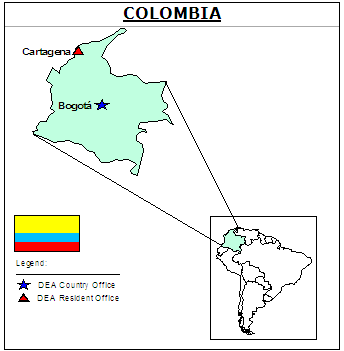 Colombia is the third most populous country in Central and South America, behind Brazil and Mexico, with an estimated population of over 45 million.76 It is bordered by Panama and the Caribbean Sea to the northeast; the North Pacific Ocean to the west; Venezuela to the east; Brazil to the southeast; and Peru and Ecuador to the southwest. According to the International Monetary Fund, the Colombian Gross Domestic Product (GDP) as of FY 2005 was $122 billion.
Colombia is the third most populous country in Central and South America, behind Brazil and Mexico, with an estimated population of over 45 million.76 It is bordered by Panama and the Caribbean Sea to the northeast; the North Pacific Ocean to the west; Venezuela to the east; Brazil to the southeast; and Peru and Ecuador to the southwest. According to the International Monetary Fund, the Colombian Gross Domestic Product (GDP) as of FY 2005 was $122 billion.
The 2005 International Narcotics Control Strategy Report (INCSR) states that Colombian drug syndicates cultivate over 70 percent of the world’s coca and refine roughly 90 percent of the cocaine on the international market.77 The INCSR also states that, Colombia supplies more than 90 percent of the cocaine and a significant amount of the heroin to the U.S. market, is a leading user of precursor chemicals, and is a major money-laundering country. The U.S. government spends more than $462 million annually on counternarcotics efforts in Colombia.
DEA in Colombia
The DEA currently operates two offices in Colombia, in Bogotá and Cartagena. The U.S. government opened a counternarcotics office in Bogotá, in 1972, which the DEA inherited upon its creation in 1973. The DEA opened an office in Barranquilla, Colombia, in 1982. This office was transferred to Cartagena in 2002. Presently, the DEA is authorized to have 109 personnel in its offices in Colombia, which is the DEA’s largest personnel allocation to any one country. The Colombian offices account for 15 percent of all DEA authorized personnel in foreign offices. As of May 2006, the Colombian offices were authorized the following personnel:
| Total DEA Personnel in Colombia Fiscal Year 2006 |
|
|---|---|
Location |
Authorized Personnel |
Bogotá |
66 |
Cartagena |
43 |
TOTAL |
109 |
| Source: Drug Enforcement Administration |
The DEA office in Bogotá, Colombia, is the regional hub for the DEA’s Andean Region. The Regional Director stationed in this office has responsibility for the DEA offices located mainly along the Andean Mountain range in South America, including both offices in Colombia, and the DEA offices in Caracas, Venezuela; Guayaquil and Quito, Ecuador; and Lima, Peru.
The Colombia offices oversee the DEA’s largest and oldest Sensitive Investigative Unit (SIU) Program. Colombia was one of the four original SIU Program countries in 1997. As of July 2006, the DEA reported that there were 203 Colombian law enforcement officers operating in its SIUs. These personnel were from the Policía Nacional de Colombia, Direccion de Policía Judicial Investigacion, and the Cuerpo Técnico de Investigacion.
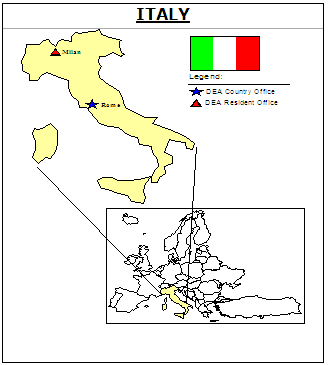 As of 2005, Italy had an estimated population of 58 million. The country is a peninsula between the Mediterranean and Adriatic Seas, and shares borders with France to the northwest; Switzerland and Austria to the north; and Slovenia to the northeast. According to the International Monetary Fund, the Italian GDP as of 2005 was nearly $1.8 trillion.
As of 2005, Italy had an estimated population of 58 million. The country is a peninsula between the Mediterranean and Adriatic Seas, and shares borders with France to the northwest; Switzerland and Austria to the north; and Slovenia to the northeast. According to the International Monetary Fund, the Italian GDP as of 2005 was nearly $1.8 trillion.
The 2006 INCSR states that Italy is a major transit point for heroin coming from Southwest Asia through the Balkans en route to Western and Central Europe. Almost all cocaine trafficked in and through Italy comes from Colombia and other South American criminal organizations. Additionally, the INCSR states that Italy fights methylenedioxymethamphetamine (MDMA) (commonly referred to as Ecstasy) from the Netherlands and hashish from Morocco. According to the INCSR the Italian authorities from January to October 2005 had arrested more than 18,000 suspects on narcotics-related offenses and seized approximately 27,000 kilograms of various narcotics.
DEA in Italy
The U.S. government opened a drug trafficking office in Rome in 1951, which was the first U.S. office opened abroad historically to concentrate on counternarcotics. When it was established in 1973, the DEA inherited this office. The Italian offices account for 2 percent of the DEA’s foreign authorized workforce. As of FY 2006, the DEA offices in Italy had the following personnel positions:
| Total DEA Personnel in Italy Fiscal Year 2006 |
|
|---|---|
Location |
Authorized Personnel |
Milan |
4 |
Rome |
9 |
TOTAL |
13 |
| Source: Drug Enforcement Administration |
The DEA office in Rome is the regional leadership for the DEA’s European Region, overseeing the activities of its office in Milan, as well as Vienna, Austria; Brussels, Belgium; Copenhagen, Denmark; London, England; Paris, France; Frankfurt, Germany; The Hague, Netherlands; Lagos, Nigeria; Warsaw, Poland; Pretoria, South Africa; Madrid, Spain; and Bern, Switzerland.
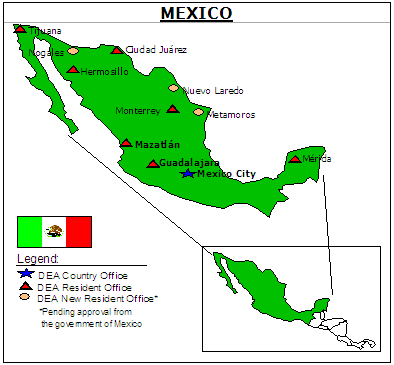 Mexico had an estimated population of over 106 million people, as of 2005. It is located between the Pacific Ocean and the Gulf of Mexico, and bordered to the southeast by Guatemala and Belize, and to the north by the United States, with which it shares a nearly 2,000-mile border. The International Monetary Fund stated that Mexico’s GDP in 2005 was over $768 billion.
Mexico had an estimated population of over 106 million people, as of 2005. It is located between the Pacific Ocean and the Gulf of Mexico, and bordered to the southeast by Guatemala and Belize, and to the north by the United States, with which it shares a nearly 2,000-mile border. The International Monetary Fund stated that Mexico’s GDP in 2005 was over $768 billion.
According to the 2006 INCSR, Mexican law enforcement seized 30 metric tons of cocaine, 1,760 metric tons of marijuana, 330 kilograms of heroin, 280 kilograms of opium gum, and 887 kilograms of methamphetamine in 2005. Mexican authorities have also seized 1,643 vehicles, six maritime vessels, eight aircraft, and recovered over $18 million of illicit proceeds associated with drug trafficking, and have arrested over 50,000 drug traffickers in the past 5 years.
DEA in Mexico
The U.S. government opened an office in Mexico City in 1963 to help coordinate efforts against drug trafficking. At its inception in 1973, the DEA inherited this office which makes it one of the oldest of the DEA foreign offices. As of June 2006, the DEA had eight offices in Mexico, and it was awaiting approval from the government of Mexico to open three additional, congressionally approved offices on the Mexican side of the U.S.-Mexican border.
The DEA Mexico City office is also the location of the regional leadership for the DEA’s Mexico/Central America Region. The Regional Director has responsibility over the activities of the offices in Mexico, as well as the DEA offices in Central America, which are located in the following locations: Belize City, Belize; Guatemala City, Guatemala; Managua, Nicaragua; Panama City, Panama; San José, Costa Rica; Tegucigalpa, Honduras; and San Salvador, El Salvador. This region also includes the DEA offices in Ottawa and Vancouver, Canada.
The eight open offices in Mexico constitute the most DEA foreign offices in a country. [SENSITIVE INFORMATION REDACTED]
[SENSITIVE INFORMATION REDACTED]78
The DEA Mexico office, like Colombia, has been part of the SIU Program since its inception in 1997. All SIU members in Mexico are from the Agencia Federal de Investigación (AFI) headquartered in Mexico City. According to the DEA, AFI headquarters centrally manages the SIU teams operating in Mexico as of June 2006.
An estimated 70 to 90 percent of all cocaine originating from South America destined for the U.S. transits through Mexico. Additionally, Mexico is the number one foreign supplier of marijuana to the U.S. and a major supplier of heroin.79 Mexico is a major source for methamphetamine that is imported into the United States. Drug cartels inside Mexico continue to be the major suppliers of methamphetamine to the United States, and seizures of methamphetamine at the U.S. border have increased every year since 2001. Mexican drug traffickers have built several clandestine methamphetamine production labs along the U.S. southern border.
Additionally, Mexico is a source country for pharmaceutical drugs like Ketamine, OxyContin®, Rohypnol®, and anabolic steroids destined for the United States.
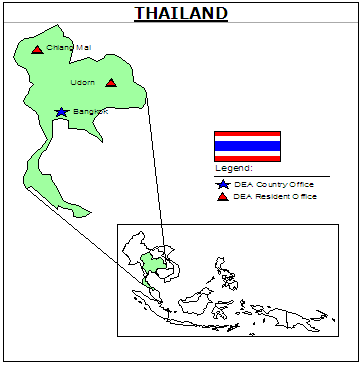 Thailand had an estimated population of 65 million people in 2005, and is bordered by Burma and the Andaman Sea to the west, Laos to the northeast, Cambodia to the southeast, and Malaysia and the Gulf of Thailand to the south. According to the International Monetary Fund, Thailand’s 2005 GDP was approximately $169 billion.
Thailand had an estimated population of 65 million people in 2005, and is bordered by Burma and the Andaman Sea to the west, Laos to the northeast, Cambodia to the southeast, and Malaysia and the Gulf of Thailand to the south. According to the International Monetary Fund, Thailand’s 2005 GDP was approximately $169 billion.
Thailand is a major transit route for heroin, opium, and methamphetamine, according to the 2006 INCSR. Thailand is also permeated by methamphetamine, commonly know as “Ya Ba”, or crazy drug. In addition, millions of tablets of prescription drugs and steroids are sold over the Internet by Thai criminal organizations. In 2005, Thai authorities seized 889 kilograms of heroin, 13.4 million tablets of methamphetamine, 32,438 Ecstasy tablets, 5,737 kilograms of opium, 9,997 kilograms of marijuana, 44 kilograms of Ketamine, 2.6 kilograms of cocaine, and 669 kilograms of codeine.
DEA in Thailand
The U.S. government opened an anti-drug office in Bangkok in 1963. The DEA inherited this office upon its creation in 1973 and currently maintains this office as well as offices in Chiang Mai and Udorn. The DEA recently closed an office in the southern Thai city of Songkhla. The three DEA offices in Thailand comprise 6 percent of the DEA’s foreign workforce, making it the DEA’s fourth largest country presence in terms of allocated personnel. As of FY 2006, DEA Thailand offices were authorized a total of 47 personnel.
| Total DEA Personnel in Thailand Fiscal Year 2006 |
|
|---|---|
Location |
Authorized Personnel |
Bangkok |
35 |
Chiang Mai |
9 |
Udorn |
3 |
TOTAL |
47 |
| Source: Drug Enforcement Administration |
The DEA office in Bangkok hosts the Regional Director for the DEA’s Far East Region. Besides the offices in Thailand, the DEA offices in this region are: Beijing, China; Canberra, Australia; Hanoi, Vietnam; Hong Kong, China; Kuala Lumpur, Malaysia; Manila, Philippines; Rangoon, Burma; Seoul, South Korea; Singapore, Singapore; Tokyo, Japan; and Vientiane, Laos.
The DEA extended the SIU Program in 1998 to its operations in Thailand. SIUs in Thailand are predominantly comprised of vetted members from the Royal Thai Police with some members from Thailand’s Office of the Narcotics Control Board.
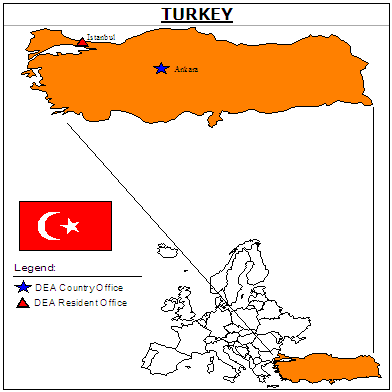
In 2005 Turkey had an estimated population of 70 million. According to the International Monetary Fund, in April 2006, the Turkish GDP was $362 billion. Turkey is bordered by Greece and Bulgaria to the northwest; the Black Sea to the north; Georgia, Armenia, Azerbaijan, and Iran to the west; Syria, Iraq, and the Mediterranean Sea to the south; and the Aegean Sea to the west.
Turkey is split between the Middle East and Europe, making it a strategic location for trafficking drugs into Western Europe. According to the 2006 INCSR, Turkey is a major transshipment and production area for illicit drugs, and it is also a base of operations for international narcotics traffickers and associates trafficking opium, morphine base, precursor chemicals, and other drugs. The majority of the opiates that originate in Afghanistan are ultimately trafficked to Western Europe through Turkey. A smaller but significant amount of heroin is trafficked to the United States via Turkey. The INCSR states that Turkish authorities seized 7,760 kilograms of heroin, 409 kilograms of morphine, 7.6 million dosages of synthetic drugs, 10,671 kilograms of hashish, and 25 kilograms of cocaine in 2005.
DEA in Turkey The third U.S. government drug-trafficking office was opened in Istanbul in 1961, and another office was opened in Ankara in 1971. When it was created in 1973, the DEA inherited these two offices. These Turkish offices account for three percent of the DEA’s authorized foreign workforce. As of June 2006, Turkish DEA offices were authorized the following personnel:
| Total DEA Personnel in Turkey Fiscal Year 2006 |
|
|---|---|
Location |
Authorized Personnel |
Ankara |
12 |
Istanbul |
8 |
TOTAL |
20 |
| Source: Drug Enforcement Administration |
The Regional Director for the DEA’s Middle East Region is located at the DEA office in Ankara. Besides overseeing the other Turkish office in Istanbul, the Regional Director is also responsible for the DEA offices in Athens, Greece; Cairo, Egypt; Islamabad and Peshawar, Pakistan; Kabul, Afghanistan; Moscow, Russia; New Delhi, India; Nicosia, Cyprus; and Tashkent, Uzbekistan. The DEA is in the process of adding three offices to this region in Bishkek, Kyrgyzstan; Dubai, United Arab Emirates; and Dushanbe, Tajikistan.
Projected population made by the United Nations Population Division.
The 2006 International Narcotics Control Strategy Report (INCSR) is an annual report to Congress prepared by the State Department in accordance with the Foreign Assistance Act.
Department of State. 2006 International Narcotics Control Strategy Report, March 2006.